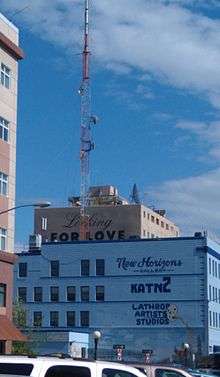KATN
KATN, virtual channel 2 (UHF digital channel 18), is an ABC/Fox/CW+-affiliated television station licensed to Fairbanks, Alaska, United States. Owned by Vision Alaska, the station is operated through a time brokerage agreement (TBA) by Coastal Television Broadcasting Company, LLC.[2][3][4] KATN's studios are located in the Lathrop Building on 2nd Avenue in downtown Fairbanks, and its transmitter is located on Cranberry Ridge northeast of the city.

 | |
| Fairbanks, Alaska United States | |
|---|---|
| Channels | Digital: 18 (UHF) Virtual: 2 (PSIP) |
| Branding | ABC Alaska (general) NewsNet Alaska (newscasts) Fox Alaska (on DT2) The CW Alaska (on DT3) |
| Slogan | Alaska's Superstation Your Alaska Link |
| Programming | |
| Affiliations | 2.1: ABC (secondary 1955–1971; primary 1985–present) 2.2: Fox 2.3: CW+ 2.4: Ion Television 2.5: Dabl (soon) |
| Ownership | |
| Owner | Vision Alaska LLC (KATN and KJUD License, LLC) |
| Operator | Coastal Television Broadcasting Company, LLC (via TBA) |
| History | |
| First air date | March 1, 1955 |
| Former call signs | KFAR-TV (1955–1981)[1] KTTU-TV (1981–1984) |
| Former channel number(s) | Analog: 2 (VHF, 1955–2009) |
| Former affiliations | Analog/DT1: NBC (1955–1996, secondary from 1985) DT2: WB 100+ (1995–2006) CW+ (2006–2017) |
| Call sign meaning | Alaska Television Network |
| Technical information | |
| Licensing authority | FCC |
| Facility ID | 13813 |
| ERP | 16 kW |
| HAAT | 230 m (755 ft) |
| Transmitter coordinates | 64°55′17.4″N 147°42′57.7″W |
| Links | |
| Public license information | Profile LMS |
| Website | www |
History

KATN debuted on March 1, 1955 as KFAR-TV, and was Fairbanks' second television station after KTVF. It became KTTU-TV (no relation to the present-day Tucson, Arizona station) on June 18, 1981 and KATN on August 18, 1984. It is now a part of the ABC Alaska Superstation and was the first TV station in Fairbanks to broadcast in color in 1967 (while KTVF was temporarily off the air due to a flood).
KFAR/KTTU was primarily an NBC station with ABC as the secondary network until 1984, when the owners of KIMO (now KYUR) in Anchorage bought the station, changed the call letters (the ATN in KATN stood for Alaska Television Network, a consortium of KATN, KIMO, and KJUD in Juneau), and made KATN the primary ABC affiliate. The station continued carrying NBC programs as a secondary affiliate until KTVF switched from CBS to NBC in 1996, in response to KATN's new ownership. Until the launch of KFXF in 1992, they were Fairbanks' only two commercial network stations.
In September 2006, KATN began to show programming from The CW (via The CW Plus) on its digital subchannel. The subchannel is called Fairbanks CW and uses the fictional call letters KWFA (the actual call letters of the subchannel are still KATN).
Smith Media sold KATN and the remainder of the "ABC Alaska's Superstation" system to Vision Alaska LLC in 2010.[5] When the sale was completed, on May 13, 2010,[6] Coastal Television Broadcasting Company, LLC entered into a time brokerage agreement with Vision Alaska to operate KATN and sister station KJUD.[2][3][4]
On October 30, 2017, Fox announced that it would move its Fairbanks affiliation from KFXF-LD (channel 22) to a subchannel of KATN on November 4.[7]
Digital television
Digital channels
The station's digital signal is multiplexed:
| Channel | Video | Aspect | PSIP Short Name | Programming[8] |
|---|---|---|---|---|
| 2.1 | 720p | 16:9 | ABC | Main KATN programming / ABC |
| 2.2 | FOX | Fox Fairbanks | ||
| 2.3 | 480i | 4:3 | CW | CW Alaska |
| 2.4 | ION | Ion Television | ||
| 2.5 | DABL | DABL (soon) |
Conversion to digital signal
KATN shut down its analog signal, over VHF channel 2, on June 12, 2009, the official date in which full-power television stations in the United States transitioned from analog to digital broadcasts under federal mandate. The station's digital signal remained on its pre-transition UHF channel 18.[9] Through the use of PSIP, digital television receivers display the station's virtual channel as its former VHF analog channel 2.
References
- Mitchell, Elaine B., ed. (1973). Alaska Blue Book (First ed.). Juneau, AK: Alaska Department of Education, Division of State Libraries. p. 136.
- Time Brokerage Agreement (Part 1 of 3) - Federal Communications Commission
- Time Brokerage Agreement (Part 2 of 3) - Federal Communications Commission
- Time Brokerage Agreement (Part 3 of 3) - Federal Communications Commission
- "Alaska TV group sold". Television Business Report. January 15, 2010. Retrieved October 4, 2015.
- Consummation Notice - Federal Communications Commission
- Miller, Mark K. (October 30, 2017). "KATN Picks Up Fox Affiliation In Fairbanks". TVNewsCheck. Retrieved October 30, 2017.
- "RabbitEars.Info". rabbitears.info.
- "DTV Tentative Channel Designations for the First and the Second Rounds" (PDF). Archived from the original (PDF) on 2013-08-29. Retrieved 2012-03-24.
External links
- Official website
- KATN in the FCC's TV station database
- BIAfn's Media Web Database -- Information on KATN-TV
